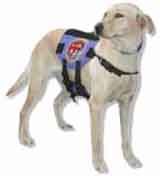Dog Behavior Problems and TrainingWhen Your Dog Runs Away |
|
|
A dog that runs away from home has somewhere to go. It is quite amazing that in most cases the owners cannot tell where their dog goes. The usual answer is, "Just out in the neighborhood to see the other dogs or something." These dogs have a definite objective in mind and usually cover the same route during each journey. Why is that route or objectives more appealing than his home environment? It must be that his environment is lacking in some respect. The root of the problem usually lies with the owner. The dog is often either over- dependent or is not in a subordinate position in relation to the owner. All corrective procedures must start with the relationship between dog and owner, except when minor external environmental adjustments are needed, such as gaining a misguided neighbor's cooperation to stop feeding the dog when he comes around. The relationship between dog and his owner must always be considered first when solving a runaway problem. When the dog is over-dependent or too independent, he must be taught, without physical manipulation, to Come, Sit and Stay on command. The owner must make a general environmental adjustment and avoid all fondling or other stimulus-response situations that subordinate the owner to the dog's whims. For example, a dog that nudges for petting, food tidbits, or to be let outside must be given some simple command, and then told "Good dog" and petted briefly when he obeys. The pet should then be ignored while the owner continues whatever activity was interrupted by the dog's solicitation. This helps reorient the dog to his owner's control and reverses the leadership position. Combined with daily training sessions and other corrective measures, this procedure produces results within one and three weeks. Owners who allow their dogs to roam free in the neighborhood are contributing to the runaway problem, and should be made aware of the dangers related to this practice. The pet's safety and health are at risk because of poisoning, road accidents, fighting, and diseases contracted from other animals. The animal may become lost, picked up by animal control officers or stolen. What is seldom considered also is that the owner may be subjected to civil suit or criminal charges if the wandering pet causes destruction of property, including fights with other dogs, or human injury. If an owner cannot appreciate the folly of allowing a pet to roam, any attempt at teaching the animal to behave at home is wasted. When the dog has been taught to accept the confines of his own property, the problem of running away is solved, and such associated problems as dashing in or out of doors, jumping fences, and other escape behavior can be dealt with effectively. Back to the Dog Behavior Problems and Training page
| |
|
Related News About Dogs ' ); // get rid of newsfeed display by carp CarpConf('poweredby',''); CarpCacheShow('http://dogguidance.com/dogblog/?feed=rss2'); ?>
|
|
|
|
|
|
Copyright © 2006-2007 dogguidance.com |


